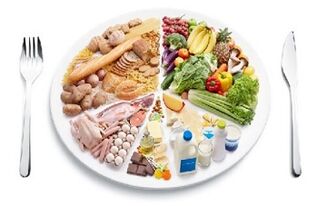
Diet for pancreatitis depends on whether the disease is acute or chronic. Remember that inflammation of the pancreas is not insignificant, because it plays an important role in digestion, metabolism and digestion of substances (proteins, carbohydrates and fats). Therefore, it is necessary to make serious changes in the diet immediately after diagnosis. Otherwise, the latest generation of drugs will be so weak.
Acute (reactive) pancreatitis
As the name suggests, the disease occurs suddenly (usually immediately after eating an irritating meal). Symptoms: burning pain in the abdomen, fever, nausea, vomiting. Risk factors: protein deficiency in the diet, overeating, alcohol abuse, smoking, greasy, spicy, fried, very cold or very hot food, sweet soda water. Sometimes anxiety is a result of gallstone disease and chronic cholecystitis.
In adults and children, nutrition for acute (reactive) pancreatitis aims to provide maximum rest to the long-suffering pancreas and at the same time reduce pancreatic and gastric secretions. The sequence of patient movements should be as follows:
- The first 2-4 days after exacerbation.It is recommended that you do not eat at all, use only small sips and small amounts of medicinal mineral water.
- Starting from the 5th day.We are gradually and very carefully expanding the diet menu for pancreatitis. It is recommended to follow the 5P treatment table for this.
- 6-7 days. Diet includes jelly, slimy soup, kefir, liquid porridge (except millet), steamed chicken, beef and fish cutlets, mashed potatoes and other vegetables in boiled and cooked form, weak tea, baked or mashed apples, hip juice.
Dietary features and sample menu
For the treatment of pancreatitis, regardless of where the patient is sent to a sanatorium or home, he must follow a diet number 5 based on the following principles:
- Daily ratio of vegetable proteins - 30 g, animal proteins - 50 g, vegetable oil - 15 g, animal fat - 45 g and carbohydrates - 200 g. The total caloric intake for pancreatitis should not exceed 2500-2700 kcal per day. The norm of drunk liquid - 1, 5 liters, salt - 10 g.
- For the first two weeks, we cook without salt.
- We eat in small portions at least 5-6 times a day to eliminate the risk of overeating.
- The temperature of the prepared food should be between 45 and 60 degrees.
- Consistency of food is liquid, semi-liquid, ie only pureed food.
The diet for acute pancreatitis involves long-term (about a year) complete elimination of smoked meats, fried foods, marinades and pickles, sour cream, butter, canned foods, muffins and fresh bread, cream, alcohol. Compliance with all of the above recommendations can prevent the development of chronic forms of the disease! The sample menu for the day may look like this:
- Breakfast:steamed omelet, water puree hercule porridge, weak tea.
- Second breakfast:milk cheese.
- Dinner:buckwheat soup, boiled meat dish, apple jelly.
- Meals:steamed fish cutlets, carrot puree, hip juice.
- For the night:kefir.
Chronic pancreatitis
This disease has another extremely attractive name - prediabetes. Indeed, if you have already gone through the acute phase unfavorably (without proper treatment), then diabetes mellitus may be the next step. The disease is characterized by two alternative stages - exacerbation and remission. Therefore, diet with pancreatitis aims to eliminate the inflammatory process and therefore turn the disease into a stage of remission.
So, from now on, your diet will be a lifelong nutritional system. And there is nothing you can do about it. You can still take diet 5 as a basis, we continue to strictly follow the basic principles. With the exacerbation of chronic pancreatitis, the diet returns to the first three stages (fasting in mineral water and the list above).
Licensed Products:
- milk, yogurt, kefir, non-acidic cottage cheese, soft cheese;
- porridge (buckwheat, oats, rice), pasta;
- vegetables (potatoes, carrots, pumpkins, squash, beets, etc. );
- wheat crackers or stale white bread;
- meat (beef, chicken, rabbit, turkey), lean fish;
- baked apple, fruit jelly, berry juices;
- oatmeal, fruit drink, non-acidic fruit juices, chamomile tea;
- vegetable broths and puree soups, celery juice.
Prohibited Products:
- sour fruits, fresh cabbage, legumes;
- spinach, sorrel, radish, radish;
- hot spices and herbs;
- fresh bread, pastries, sweets;
- sausage, smoked meat, canned food, eggs;
- meat, fish broths, cabbage soup, borsch;
- alcohol, carbonated soft drinks;
- sweets, ice cream, sour cream, cream;
- fried foods.






























